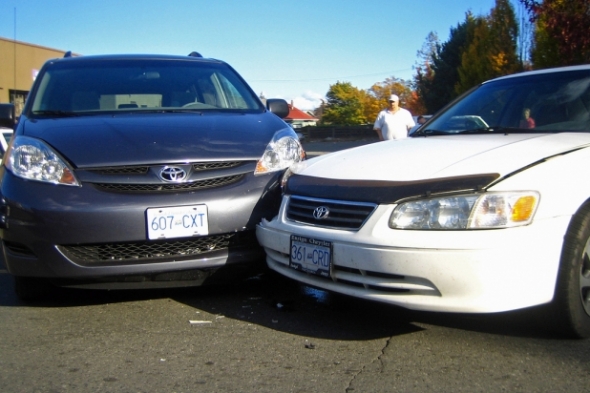This is Part 2 in a two-part series on automobile insurance fraud. Part 1 in the series appears here.
Who Participates In This Type Of Insurance Fraud?
Just about anyone. You'd be surprised. Even people who consider themselves upstanding citizens will get drawn into the business, because they see it as a victimless crime. One of the first cases I investigated involved a college-educated, former Farmers Insurance adjuster from Ohio. One day, he just decided to go to the dark side of the earth and started staging collisions from Ohio to California. He got away with $11 million before we caught him and put him in prison. He had so much activity going on that he carried a briefcase with him, and in that briefcase were 13 valid licenses from Colorado, Ohio and Texas — all valid — along with lots of crib notes from all of his activity. In an unlucky turn of events for the fraudster, he was stopped for speeding one night. As he opened his briefcase to get out a driver's license, that sheaf of crib notes was visible to the highway patrol officer, who reached right over his head and grabbed it. Lesson learned. Keep your crib notes to yourself.
People don't necessarily set out to go into insurance fraud as a career, but it's easy to see the attraction, said Borloff. "When you're first introduced to the people in this business, they say, 'This guy, he's in the insurance business,' and everybody understands he doesn't have an insurance company, he's in a different side of the business. But he's a well-to-do guy, with a house in Beverly Hills, with a car, with everything. And you ask yourself, 'Why can he do it and I can't?' And then you start to learn."
It starts easily enough. The newcomer becomes the defendant in one staged accident, and voilà, $1,000 just falls into his lap. "It's a big deal for this guy," said Borloff. "He just calls the insurance company, and that's it, he's a rich man. He wants to do it again. Trust me, he wants to do it again and again." However, a savvy criminal enterprise will not use this guy again. They will use another guy, then another. So now our newcomer is intrigued to work it from the other side of the fence, to run his own business.
First he needs to recruit lawyers and doctors — and that's surprisingly easy, said Borloff. Where would you find an attorney willing to take such a risk? "Word of mouth or the Yellow Pages," Borloff quipped. "Any attorney wants more business." The business is so attractive that it is relatively easy to find professionals who want to be a part of it.
"Think about it. Who is this lawyer guy? He spent three years in law school, and he spent a lot of money. He is out of school now, and he has a lot of debt. What can he get? He can get a job for about $40,000 to $50,000 a year at the most, if he is lucky. So he opens his own office. He has just one secretary, and he's waiting for clients. But there are no clients, because there are a lot of lawyers around with the big names, big firms and so on. He is desperate.
"If you come to this guy and say, 'You know, I can give some business to you,' what will he say? As a lawyer, he is like an innocent girl — he wants seduction. You should not say to him, 'It's a staged accident.' No, you say, 'I can give you some business, but you will have to follow my instructions and pay me 50 percent.' He says, 'Of course,' and he agrees. If you teach him properly, he will properly do his business for you."
Is it really that easy? Are there attorneys willing to look the other way at the likelihood that their cases are fraudulent? Yes. In a separate case, when I had an attorney in an investigation room and got him to confess, I asked him, "What were you thinking?" This was an aha moment. He said, "It's quite simple — there aren't enough real accidents to go around." It's that simple.
Besides, real accident cases get complicated and messy, Borloff said. "Attorneys don't like real accidents because there are so many problems. There isn't a cooperative defendant — he says, 'No it didn't happen.' There are too many problems. It's easy for me to work with defendants who say, 'Yes, I hit him, I was not paying attention,' and with attorneys who want money."
Many of the people involved in these schemes don't quite see it as wrong but rather as a rightful Robin Hood redistribution of monies. "I had one good, white-bread American guy. He was the perfect defendant," said Borloff. "He did the accident, and then on the way home, he sees somebody not driving the proper way. He gets on the phone, calls the police, and gives them the license plate number. I said, 'You turned him in? You broke the law too.' He said, 'No, that was the insurance company.' Sometimes the insurance company is not seen as the good guys."
Fraud Ring Leader: "This Is A War That Will Never End"
"If you want to win this war, you can't do it," said Borloff. "It's like the Cold War between the USA and Soviet Union. There was intelligence and counterintelligence, and it went on for a long, long time." Insurance companies develop more sophisticated fraud detection and prevention tactics, but the criminal enterprises adapt and become more sophisticated too. An insurance company known to have strong defenses may repel fraudsters, but only for awhile. Pitted against the fraud rings, insurance companies are at a disadvantage, said Borloff.
They lack depth in claims adjusters. "A good, educated adjuster knows how to work — he has some police experience, maybe some counterintelligence experience," said Borloff. "I ask you, how many adjusters do you have with these credentials? I can tell you 1 percent is a generous calculation."
Even if you can recognize staged collisions, there's still generally a payout. "You can try to fight it, but it's probably just to reduce the amount you have to pay," said Borloff. Adjusters can try to bluff — say that the examination of the car indicates there weren't four passengers, or that damages are inconsistent with the accident description — but that doesn't work. The stager knows a lie when he hears it.
The legal system doesn't offer much redress. When a claim looks suspicious, a smart adjuster asks for a deposition and asks smart questions of the plaintiff in front of him. He may do his best, probing for details, hoping to ferret out inconsistencies. "But it's worthless," said Borloff. "It doesn't matter what the answers are. If the people said back pain the first time, and neck pain the second time, what does it prove? It proves nothing. You can't go to court with this stuff. After the deposition, the adjuster doesn't have a lot of choices. He has to negotiate the price."
The adjuster can make a lowball offer, but a good defender will push back, knowing the adjuster's supervisor will approve more, and the insurance company doesn't want to go to court. In court, the insurance company can only argue on the facts, but the facts are that the incident did happen, and the plaintiffs do report that they suffered pain and injury from it. Can you prove they didn't? You can't pressure defendants to recant, because they're in bed with the criminal enterprise. They've got the money and face jail time if they confess.
"In small claims court, insurance companies have no chance," said Borloff. "A claims adjuster can come and represent the company, but if it happened, it happened. If you say you have pain, I have pain, we have a medical bill, and you have to pay toward this. I have a limit of $5,000, and each defendant can ask about this amount of money. And what does this situation get insurance companies? Nothing but a lot of trouble, and more trouble. The adjuster doesn't want this problem. His supervisor doesn't want this problem." The fraud enterprise wins.
Let's have a reality check here. The insurance industry will never stop this. People are going to try to scheme our insurance system as long as the system we have in place today exists, and ours is one of the best in the world. It takes care of consumers when they get in trouble. But with that, you will always have people thinking of ways to scam the money. Change the system, and they come up with a new scheme. This is just what people do.
How One Investigative Team Won
The fight against insurance fraud may be a never-ending war, but there are still skirmishes to be won. I led a five-year undercover investigation of a large and sophisticated organized crime ring in Southern California — Borloff's, in fact — and won.
We started with 63 suspected fraudulent claims that were on file in the San Diego office of the Department of Insurance. There were quite a few interesting outliers in those claims. For one, everybody was of Russian descent. These were all rear-end collisions, sudden stops. Now, we all know that sudden stop rear-end collision is a quick pay. It's pretty easy to determine at-fault in these collisions — a couple hundred of them happen every day in Southern California. It's not that big a deal.
Then an individual in custody for an unrelated matter came forward and offered information that made these claims look particularly interesting — even named two primary players. A formal task force was established with the equivalent of a joint powers authority between federal, state and municipal law enforcement. An undercover officer was introduced into the San Diego community to try to identify the ring leaders and learn how they were recruiting others into the organization and conducting business.
I didn't want to chase stuffed passengers or street offenders at the lower level. I wanted to go deeper into the organization — to identify the stagers, attorneys and physicians who facilitated those claims. And it worked.
A Collaborative Effort
The undercover operation was a joint effort of the California Department of Insurance's Fraud Division, the FBI, the San Diego Police Department, the Immigration and Naturalization Service (INS), and the National Insurance Crime Bureau (NICB). Undercover agents came from the California Department of Insurance, the San Diego Police Department, the California Department of Health Services, and the Bureau of Narcotics Enforcement.
Seven major insurance companies cooperated by providing pretext policies set up solely for the purposes of the investigation. Only the companies' regional vice presidents of claims and Special Investigations Unit directors knew about the investigation. They agreed to have the claims legitimately paid, so the money could be tracked and there would be no suspicion of law enforcement involvement.
A lot of thought and effort went into this to backstop the identities of the undercover people. If a private investigator or lawyer ran these people, they would show up as true legitimate people with valid Social Security numbers, credit histories, houses, vehicles — it was backstopped to the hilt. You'd have no idea that it was law enforcement.
Working From The Inside
We successfully infiltrated this ring for more than 18 months and were staging collisions in San Diego, Los Angeles and San Francisco. Borloff was identified in the very first staged collision, and then the lead undercover detective partnered with Borloff to stage more collisions and car thefts. Borloff gave instructions to his new business partner about how to get involved in this game. For every car and policy he provided, the undercover officer received $2,500 – a total of $75,000 over the course of the investigation.
Little did Borloff know these cars were coming from the NICB salvage pool, and every move was being recorded. During the five-year period, Borloff was responsible for staging more than 100 automobile collisions, exposing the insurance industry to an estimated $2 million in fraud losses.
Five Years To Success
It was kind of dicey. The [cooperating] insurance companies paid out more than $230,000 in claims into this. However, everybody had the bigger picture in mind — the potential economic loss prevented (PELP), an FBI metric that forecasts the money that would have been lost if the criminals continued their activities unabated.
When it was time to strike, the United States Attorney's office in San Diego handled federal prosecution and the Los Angeles County District Attorney's office handled the state prosecution. This was a seminal case that eliminated the issue of double jeopardy. In the State of California, you can arrest and convict someone in federal court for mail and wire fraud with a scheme of insurance fraud, and then charge them at the state level with insurance fraud, and it's not double jeopardy.
I brought the investigation from cradle to grave. I started as the supervising agent in the San Diego Fraud Division of!ce, and by the time the investigation was over, I was captain of that office. The investigation netted attorneys, physicians and chiropractors along with their office staff, eight cappers and 44 claimants — and effectively shut down one of the largest such rings in Southern California.
The Information Imperative
"The main problem for insurance companies is they don't have enough information," said Borloff. "When the adjuster discusses the case, he knows nothing. He knows just this is the car, this is the car damage, these are the people. He can check the records — see these people didn't have an accident for two years, three years and think they sound like nice people. But he's still suspicious, he pursues it all the way, and still he gets nothing, because it's still trouble, still problems."
In order to detect suspicious claim activity, insurance companies need access to transaction information and supporting detail that typically resides in different systems. Transactions viewed in isolation could appear normal, but they might look quite different if you could correlate those transactions across related entities. However, a unified view based on multiple internal data sources is rare. Rarer still is the organization that has augmented that view with external data as well.
As part of an 18-month Command College program of graduate study, I designed a virtual office environment for a law enforcement environment. After graduation, that work led to an assignment to design a fusion center to promote information-sharing among federal, state and local entities. The fusion center I designed was the first in the nation to incorporate law enforcement data and financial data, which led to new discoveries. For example, we threw the system up for a test run, and investigators in the San Francisco Bay Area were playing with it. From working with the data and social networking analysis, we found two chop shops in Dallas that the local police department didn't know about.
Smarter integration and analysis of data will be a strong defense to the growing fraud problem, as well as a way to meet the pressures to achieve more with less. The data being gathered through the claims process is growing bigger and bigger, so you need to start looking at things differently and working smarter, and that means leveraging your data together. A number of statistical approaches can be created to build a solid predictive solution. For instance, when you combine business rules, anomaly detection (finding outliers), and social media analysis, you can identify suspicious claims even if there is no prior claim history.
Getting a handle on the fraud problem is not about processing more cases. It is all about working the right cases to make an impact to reduce fraud. If you do not identify the true cost drivers in fraud — the licensed professionals, administrators, cappers, stagers and other individuals controlling the criminal enterprises — you will never truly reduce the amount of insurance fraud in our communities. But when you apply best practices and analytics together, you create a powerful tool and business model to reduce fraud and provide great ROI for anti-fraud programs.
This series of articles is taken from the SAS white paper of the same name. © 2013, SAS Institute Inc. Used by permission.





